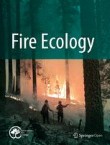Fire Ecology is the official journal of the Association for Fire Ecology.
Characterizing persistent unburned islands within the Inland Northwest USA
In the Inland Pacific Northwest of the United States, fire is a dominant driver of ecological change. Within wildfire perimeters, fire effects often vary considerably and typically include remnant patches of u...
